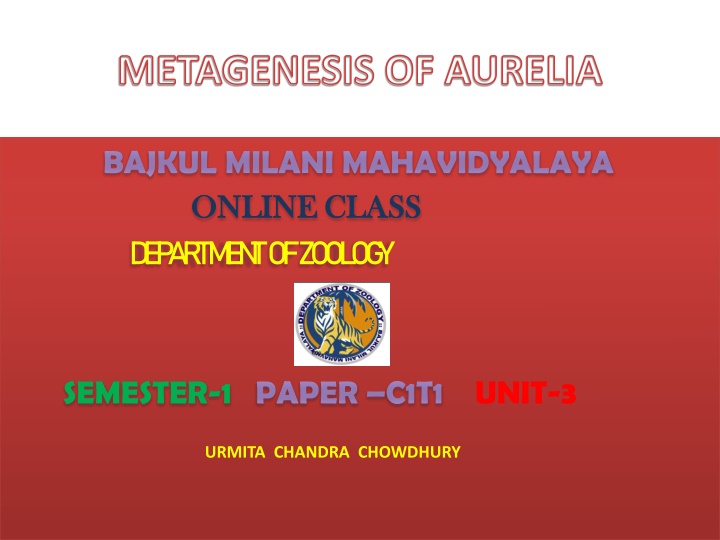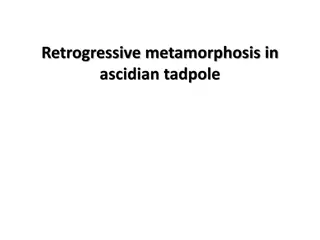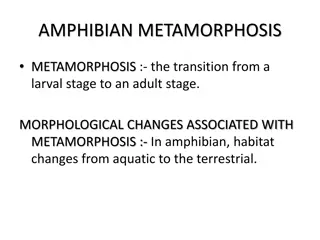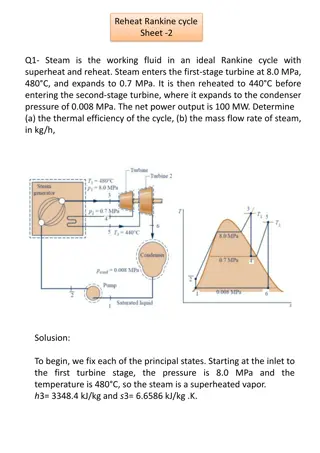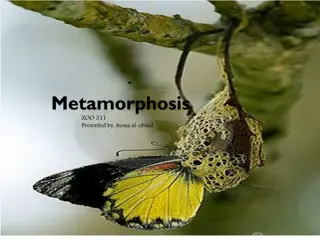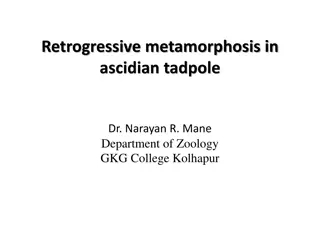Metamorphosis of Aurelia: A Fascinating Life Cycle
Aurelia, a dioecious species, exhibits a unique life cycle involving male and female sexes, fertilization processes, formation of planula larva, scyphistoma, and ephyrae. From the initial gonad development to the eventual budding and separation of offspring, this intricate journey showcases the marvels of nature's creation.
Download Presentation

Please find below an Image/Link to download the presentation.
The content on the website is provided AS IS for your information and personal use only. It may not be sold, licensed, or shared on other websites without obtaining consent from the author.If you encounter any issues during the download, it is possible that the publisher has removed the file from their server.
You are allowed to download the files provided on this website for personal or commercial use, subject to the condition that they are used lawfully. All files are the property of their respective owners.
The content on the website is provided AS IS for your information and personal use only. It may not be sold, licensed, or shared on other websites without obtaining consent from the author.
E N D
Presentation Transcript
METAGENESIS OF AURELIA BAJKUL MILANI MAHAVIDYALAYA ONLINE CLASS ONLINE CLASS D E P A RTM E N T OF ZOOL OG Y SEMESTER-1 PAPER C1T1 UNIT-3 URMITA CHANDRA CHOWDHURY
AURELIA LIFE CYCLE Aurelia is dioecious species, in other words male and female sexes are separate but there is no sexual dimorphism. Testes and ovaries are similar in appearance. The medusa form has four horseshoe shaped gonads on the floor of the stomach. The gonads are red or purple in color. The free arms of all the gonads are directed towards the center of the umbrella. The gonads are clearly visible through the semitransparent body of the jelly fish.On maturity ova and sperms break into the gastro vascular cavity and pass out of the mouth with the outgoing water current. These eggs and sperms are loaded in the frills of the oral arms.
Fertilization : The spermatozoa after being released from the body through the outgoing water current swim about till it reached the ova. The ova are fertilized in the stomach of the female or also in the oral arms. Thus the fertilization in Aurelia is said to be internal or external.
Formation of planula larva The frills of the oral arms serve for temporary brooding. In these frills the zygote undergoes early development and forms ciliated larval stage called as planula larva. The zygote undergoes holoblastic divisions to produce solid ball like morula. The morula is transformed into single layered blastula with a fluid filled cavity called as blastocoel. A two layered gastrula is developed by the invagination. Gastrula has an inner endoderm and an outer ectoderm. The blastopore of the gastrula is not completely closed. The embryo now elongates and its outer cells become ciliated and finally the blastopore closed. This ciliated larva is called as planula larva.
Formation of scyphistoma: The ciliated planula larva after a short free-swimming existence attaches itself to a substratum by its aboral end. After the attachment the cilia of the larva are lost and a mouth opens at the oral end. The larva now elongates and gets metamorphosed into a small trumpet shaped polyp. Tentacles develop around the mouth. Mouth becomes square in outline and its edges become elongated to form a short manubrium. Now the larva looks like a trumpet-shaped hydra and is called as hydratuba or young scyphistoma. Scyphistoma feeds and grows in size and survives in this stage for several months. It also shows budding and the buds eventually separate from the parent.
Formation of ephyrae: The formation of ephyrae from the scyphistoma is called as the process of strobilation. In autumn and winter, scyphistoma undergoes strobilation. The scyphistoma distally develops a series of ring- like transverse constrictions. These constrictions gradually deepen and the organism now resembles a pile of minute discs placed one above other. At this stage, the scyphistoma with the segmented body is called as strobili and each of the segments is called as ephyra larva. The ephyrae are connected with one another by muscular strands.
Ephyra: A newly released ephyra is microscopic and gelatinous creature. This creature has a well-developed tetramerous symmetry. The edge of its umbrella body has eight bifid lobes separated by eight deep adradial indentations or clefts. The distal ends of each lobe are deeply notched to form a pair of lappets which are sensory in nature. The space between the two lappets has a short tentacle which is the future tentaculocyst. Ephyra also possess manubrium and a four edged mouth. Ephyra swims actively in sea water and feed on small organisms like protozoans. The lappets help in catching the prey and transferring the prey to the mouth.
